Top 7 Distortion Effects For Metal – The World Of Endless Gain
We may also earn commissions on purchases from other retail websites.
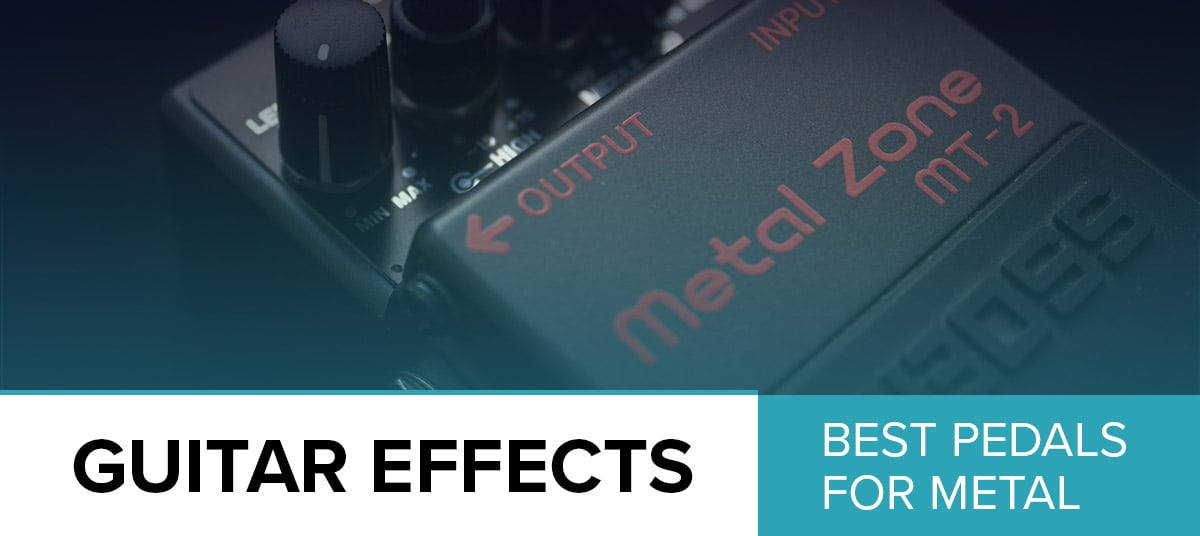
Since the '80s, metal has been constantly growing as a genre. If there's one component to a proper metal tone, it's a gain-rich distortion. Today we're going to spend some time talking about distortion pedals which work great for metal music and discuss how to properly dial in your tone.Before we get into that, we're going to list our top 7 picks for this category. By the time you're done reading this guide, you should have a proper understanding of what it takes to find a good metal tone, and how you can use distortion pedals to your advantage.Last Updated Nov-27-2018.
Top 7 Metal Distortion Pedals:
| Image | Guitar Pedal / Rating | Summary | Check Price |
|---|---|---|---|
+ -  | Electro-Harmonix Metal Muff Total of 4.83/5 | A truly impressive source of pure gain that's easy to work with. | |
+ -  | Wampler Triple Wreck Total of 4.72/5 | Massive amounts of gain paired with a great EQ and proper controls. | |
+ -  | MXRM116 Fullbore Metal Total of 4.68/5 | A raw and simple pedal that comes packed with plenty of gain. | |
+ -  | Rocktron Metal Planet Total of 4.58/5 | Brutal, in your face distortion pedal with plenty of gain to offer. | |
+ -  | Boss Metal Zone MT-2 Total of 4.68/5 | By far one of the most popular metal dist boxes ever created. | |
+ -  | TC ElectronicDark Matter Total of 4.57/5 | A budget friendly dist box that packs a heavy payload of gain. | |
+ -  | Boss DS-1X Total of 4.55/5 | A well designed and balanced gain pedal that won't overwhelm your tone. |
Electro-Harmonix Metal Muff
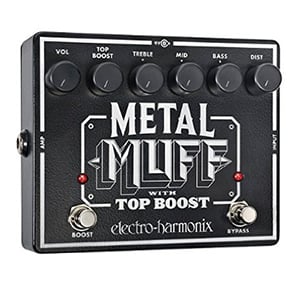
| Controls: |  |
| Features: |  |
| Performance: |  |
| Value: |  |
When people mention Electro-Harmonix, first thing that many think of is the legendary Big Muff Pi. However, this brand offers a much spicier package than that. It goes under the name of Electro-Harmonix Metal Muff, and it is just savage.
The pedal features a simple chassis with a busy control interface. They have included a three band EQ to help you manage the gain, but also a boost mode that adds even more heat into the signal.
In terms of performance, this thing can take you anywhere from classic metal to fully saturated modern madness. It works well with both passive and active pickups, although it is fairly easy to push it over the top. It's a proper dist box.
Wampler Triple Wreck
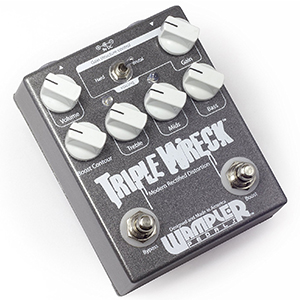
| Controls: |  |
| Features: |  |
| Performance: |  |
| Value: |  |
Wampler Triple Wreck might seem simple and ordinary, however it is everything but. If we could translate its performance into words, it would probably read like a sentence full of obscenities with a huge exclamation mark at the end.
Here's the deal about Triple Wreck. It packs a massive amount of gain right out of the box. Then it takes more gain and adds it to that pile. Wampler has managed to make such a ludicrous setup quite viable thanks to their efficient three-band EQ and smooth gain curves.
In other words, Wampler Triple Wreck isn't the barbarian it seems to be when you first see it. If you are a fan of Peavey's 5150, you'll absolutely love this pedal.
MXRM116 Fullbore Metal
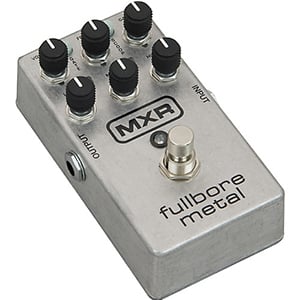
| Controls: |  |
| Features: |  |
| Performance: |  |
| Value: |  |
MXR is one of the oldest brands in the business, but that doesn't mean that they aren't capable of answering the demands of a modern guitarist. When it comes to metal music, their MXR M116 Fullbore Metal is about as good as it gets if you are after bang for the buck value.
This pedal not only delivers that raw distortion, but it also comes with all the tools necessary to bend that performance to meet your needs. Simple on the outside, Fullbore Metal is fully analog and features a built-in noise gate as well as true bypass.
Thanks to its versatile nature, you can get this pedal to work great even with underpowered single coil guitars, which is awesome.
Rocktron Metal Planet
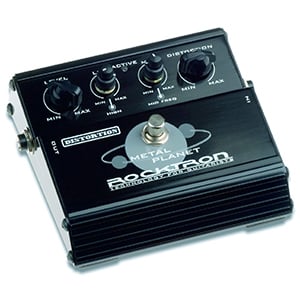
| Controls: |  |
| Features: |  |
| Performance: |  |
| Value: |  |
Rocktron is not usually among the first brands that come to mind when you think of a rich distortion. Even so, they have proven to be capable of delivering exactly that. Rocktron Metal Planet is a no-nonsense metal box that is designed to do one thing and one thing alone.
If you need gain, this thing delivers. Simple as that. Rocktron went with a somewhat unique layout of controls but also some unusual features. We're looking at a pedal that packs a four-band EQ, which really allows you to nail down that perfect tone you're looking for.
Compared to some of its more esteemed competitors, it lacks finesse. However, that can sometimes be a good thing depending on the user.
Boss Metal Zone MT-2
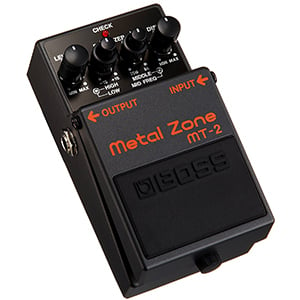
| Controls: |  |
| Features: |  |
| Performance: |  |
| Value: |  |
The world of metal distortion pedals is diverse, but most guitar players out there tend to relate one model with this niche segment. Boss MT-2 Metal Zone is a misunderstood dist box that is often seen as a newbie choice.
However, if you apply some finesse to it, MT-2 raises to a whole new level. Simple in design, Boss has made the Metal Zone into a versatile tool that brings a lot of gain to the table. Thanks to its four-band EQ, you can alter the performance in a variety of ways.
Anything from a mild ’80s sound to a modern gain-heavy distortion can be found within MT-2’s range. It is a great choice for those who want simple efficiency.
TC ElectronicDark Matter
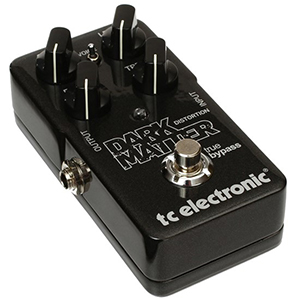
| Controls: |  |
| Features: |  |
| Performance: |  |
| Value: |  |
TC Electronic are known for delivering some of the most practical and efficient guitar effects on the market. When it comes to affordable gain-rich distortions, TC Electronic Dark Matter is hard to beat.
This pedal features a compact chassis that can take a beating if necessary, allanalog circuitry and most importantly, loads of gain. Its sound can be described as a tube head pushed to the brink of failure, but without all of the risks usually involved with doing something like that.
In our eyes, it is a true affordable masterpiece that had no trouble keeping up with our demands. If you need a good, versatile distortion pedal on a budget, this is about as good as it gets.
Boss DS-1X
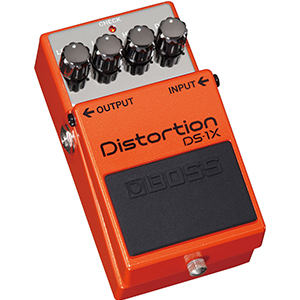
| Controls: |  |
| Features: |  |
| Performance: |  |
| Value: |  |
The range of Boss distortions includes some rather interesting pedals. One that really stands out is their Boss DS-1X. Due to a similar name and color finish, it is often confused with the classic DS-1. However, these two pedals don't have much in common at all.
DS-1X is a gain package that brings you a hot tone but with style. Boss definitely nailed the tone when it comes to classic metal, giving us a tool that can send us back in time. On its own, Boss DS-1X has proven to be a rather versatile pedal.
The controls are both intuitive and effective, especially if you like to finely tune your sound. Generally speaking, it is a great piece of kit.
What Makes A Good Metal Tone?
Distortion as a guitar effect, has been around for a while now. Even though it has actual applications in other music genres, it is the most popular tool of choice in metal. So, what makes a good metal tone? This question is a very controversial one and definitely has no single answer. In a perfect world, you would want to get yourself a proper tube amplifier and get all of your flavors from its dirty channels. The only problem here is that those amplifiers, namely stuff like Peavey's 6505 and similar, tend to cost quite a bit of money. A more affordable solution is to get a good pedal. This way, it doesn't really matter what kind of amplifier you have in front of you as the pedal is taking care of your gain needs.
With that said, we have to make a small disclaimer. A distortion pedal will rarely ever live up to the dynamic range of a proper tube amp. Given the choice, most guitar players will go with an amp. It simply offers a higher resolution, wider range tone than a distortion pedal ever could. In away, dist boxes are there as a shortcut, but that doesn't mean that you can't get some pretty awesome results with them.
How To Dial In A Good Metal Tone?
We have already mentioned that the definition of ‘a good metal tone' hasn't yet been established. However, there are some mistakes that you definitely want to avoid when trying to find your perfect tone profile. The issue with distortion pedals is also what makes them so great, which would be gain. One thing you will see most beginners do is feed the signal with boat loads of gain, scoop those mids and max out bass and treble.
This setup may sound awesome in your bedroom when you are practicing, but it certainly doesn't work that well on stage. Here's the deal. When you pump the signal full of gain, you are essentially reducing the resolution of your tone. Sure, your palm mutes are going to sound brutal and savage, but that doesn't mean much when you have killed off your guitar tone's ability to render details properly. Things only get worse when you scoop those mids.
What you want instead is a balance of gain that doesn't drown out guitars in a standard mix. Just by reducing the gain to a more sensible level, you are already going to cut through the rest of the band much easier. If we consider the fact that you are battling a bass guitar and drums, both of which are bass heavy instruments, it becomes clear that you need to put more emphasis on mids and trebles. Finding a balance in this regard can yield a very powerful guitar tone that lacks nothing.
Choosing The Right Pedal When Playing Metal
Finding a perfect dist box comes down to several things, with personal preference being a major factor. Your choice will also depend on the genre of metal you are playing and your role in the band. Generally speaking, those who are just starting out should find something that is fairly neutral. By that we mean a distortion pedal that isn't too heavy on gain and has decent amount of tone shaping options available. If we put that step of decision making aside, we are left to find a model with good hardware.
The last thing you want in your distortion pedal is noise. In a more casual setting, you could probably get away with it. However, this changes quickly if you plan on actually performing on stage. Most of the models on our list are fairly quite. Some pedals more so than other. As a matter of fact, that MXR M116 Fullbore Metal comes with a built in noise gate, which definitely helps in this regard.
With all that said, you should keep on mind that most distortion pedals offer plenty of range. The key here is the experience of the person using the pedal. You might feel limited if you are a beginner, but when you spend some time playing with your signal chain, you will soon realize that there is far more potential in there than it appears at first.
Minimizing The Effect Of Gain On Your Tone
Gain, as awesome as it can be, is actually a double edged sword. It is so easy to go overboard without even noticing. The way many guitar players use their distortion pedals is to plug them straight into a clean channel. After all, it is only logical, right? Here's the deal. Using a solid state dist pedal with the clean channel is the fastest route to a half decent tone. It is so easy to do and guitar players tend to be lazy at times. The issue with this method of adding gain is that it can overwhelm you in a heartbeat.
A much better solution is to pair your distortion pedal with the dirty channel on your amplifier. This way you are not overwhelming the amp with outside gain, but rather using the pedal as a boost to your dirty channel. Naturally, you have to be rather conservative with that gain knob on your distortion pedal. Nailing a guitar sound created using this method is all about finesse. At the end of the day, using both gain sources allows for a much better defined tone and much more maneuvering space.
Are Distortion Pedals Viable In A More Serious Setup?
As we have said before, the absolute best way to get yourself a great distortion is to use a good tube amplifier. However, that doesn't mean that distortion pedals are not viable for serious use. Here is a simple analogy. Think of guitar effects as a set of spices. While most amateur chefs might rely heavily on one or two favorite spices, a professional will use them in a much more refined way, but still use them nonetheless. Same goes for guitarists and distortion pedals. They are a source of gain that can be applied in many different ways in order to achieve a certain goal. Maybe you have dialed in your tone, but you want just a pinch of girth on top.
A distortion pedal is a perfect tool for the job. Some dist pedals have such a unique signature that guitar players often use them despite having a monster of a tube amp at their disposal. It is pretty situational. The thing with effects pedals in general is that you definitely want to have more rather than less. This way you can just pull out the ones you need, when you need them. Additionally, even the most elite guitar players out there tend to change their tone profiles from time to time. In other words, nothing is set in stone.
Can A Distortion Pedal Push Single Coils?
Guitars that features single coil pickups are notorious for being hard to use with distortion effects. Compared to humbuckers, they simply sound too hollow. This is one place where the abundance of gain tends to help out a lot. If you push enough gain through your signal chain, even the most conservative Stratocaster will sound good. As a matter of fact, distortion pedals will easily make the cheapest set of pickups sound powerful. With that said, you still have to be careful not to go too far. There's nothing worse than a tone that is so overwhelmed with gain that you can't even make out what the person is playing.
Conclusion
Distortion pedals are a shortcut to a great metal tone. That is simply the fact of the matter. Not only that, but they are a perfect tool you can use to learn how to deal with gain in general. Models we have listed above are easily among the best in their class. We have included some pedals from a variety of price ranges, thus making sure that everyone can find something regardless of their budget. If you are just getting into metal, any one of these dist boxes will give you that classic, gain-heavy tone that makes metal so awesome.



Reader Interactions